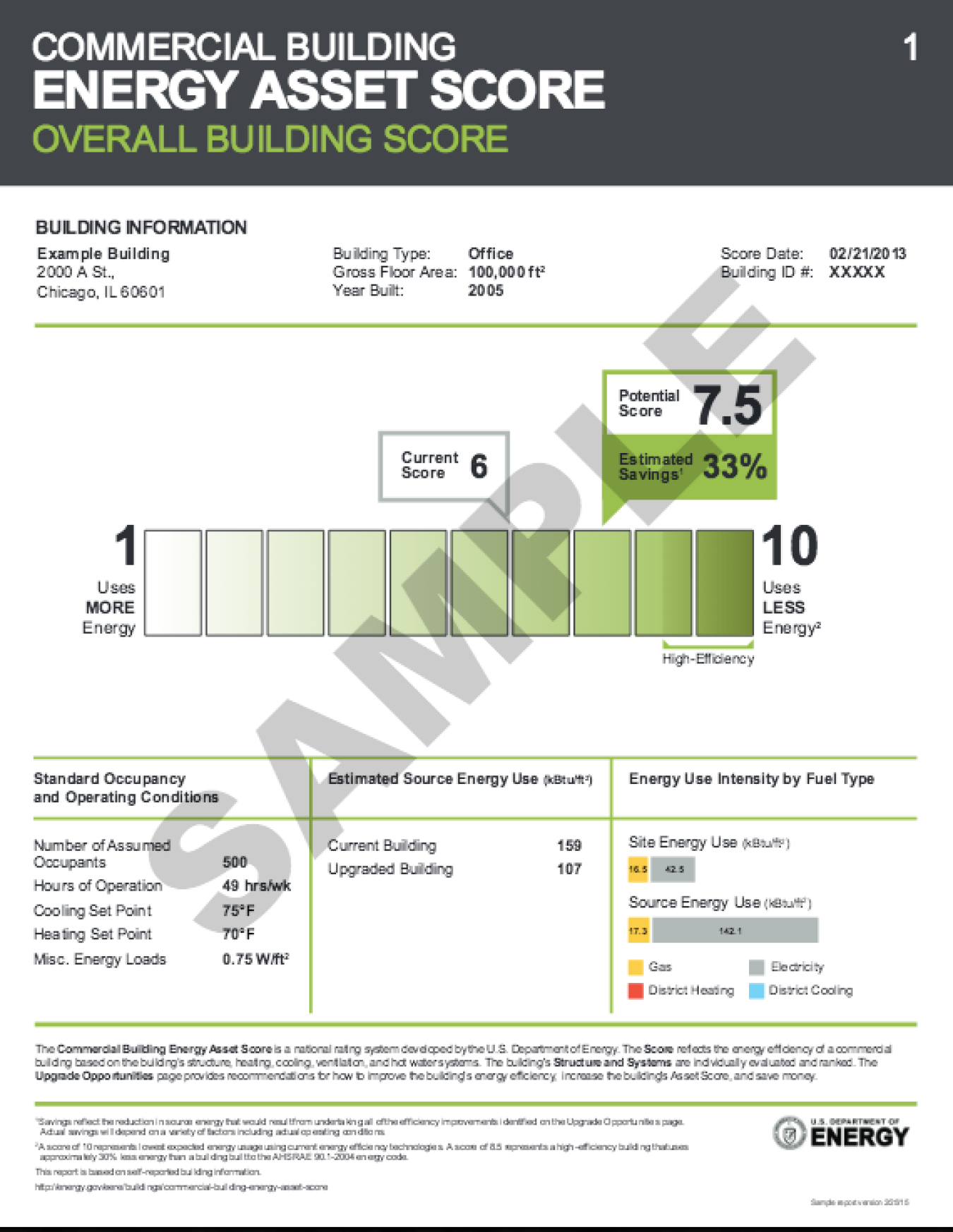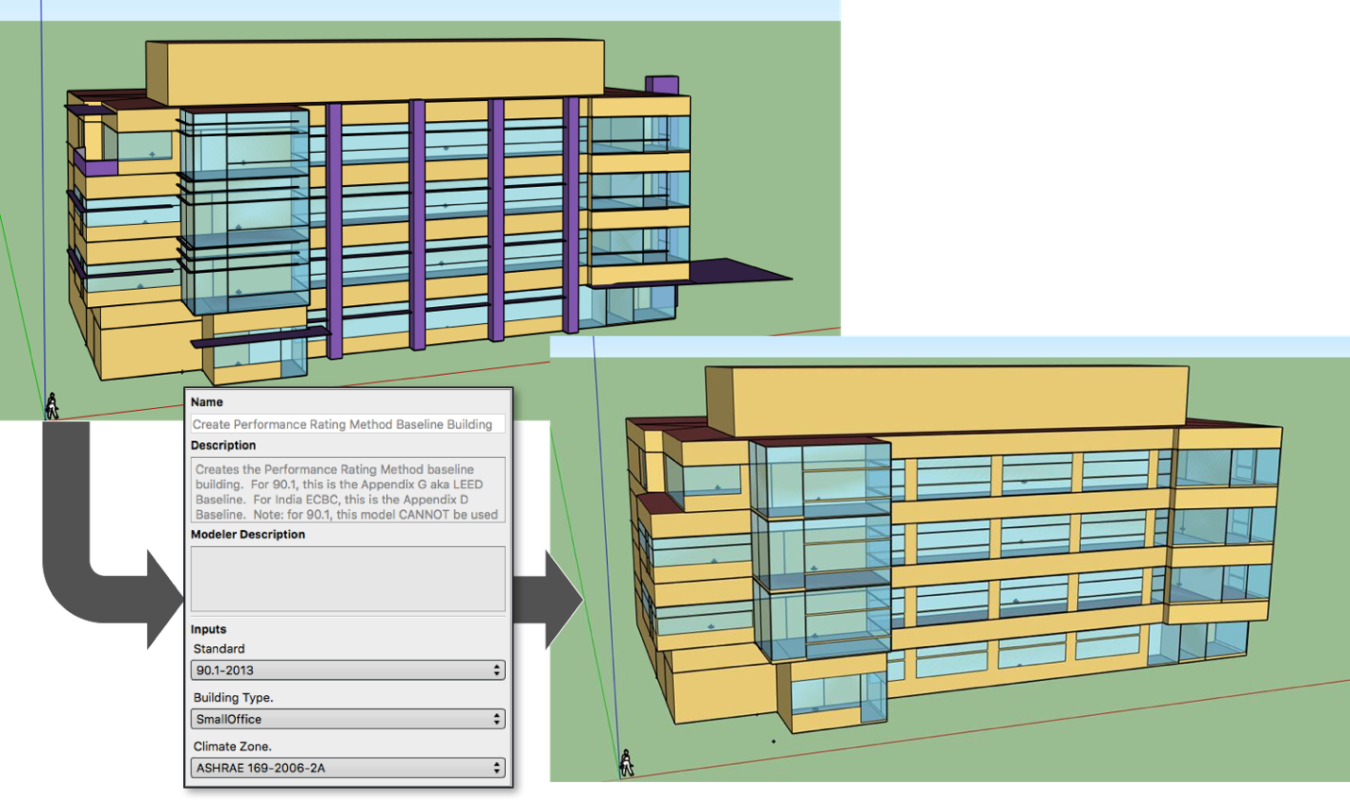A building’s inherent energy performance is attributed to the building itself rather than to weather, occupancy, or use.
March 29, 2017A building’s inherent energy performance is attributed to the building itself rather than to weather, occupancy, or use. Building energy modeling (BEM) can isolate inherent performance by controlling for exogenous variables. Inherent performance rating is the basis of procedures such as compliance-demonstration for codes like ASHRAE Standard 90.1, green certification via programs like USGBC’s LEED, the calculation of asset ratings such as DOE’s Energy Asset Score, and performance documentation for tax credits and utility incentives.
Comparing Buildings to One Another
Asset ratings such as DOE’s Energy Asset Score compare the inherent energy-efficiency of different buildings. These comparisons are nearly impossible to conduct in a controlled way in the physical world—ratings based on measured data like ENERGY STAR® are useful but do not fully isolate inherent performance from weather, occupancy, and use. These comparisons are easy to conduct with BEM using standard values for weather, occupancy, and use.
The American Society of Heating Refrigeration and Air Conditioning Engineers (ASHRAE) defines standard modeling inputs for different space (offices, corridors) and building types (hospitals, schools). These inputs cover occupancy, occupant activity, plug-loads, and lighting levels at hourly resolution, along with ventilation rates and thermostat settings. These values represent typical use and were extracted from large building surveys such as the Energy Information Administration’s (EIA) Commercial Building Energy Consumption Survey (CBECS).
DOE’s Asset Score uses these standard values to calculate energy use intensities (EUIs). These EUIs are weather-normalized and mapped to building-type specific “technical” scales created by simulating a range of configurations—from efficient to inefficient—under the same standard weather and operating assumptions, to obtain 1-10 scores that can then be directly compared.

DOE’s Energy Asset Score allows the inherent energy performance of different buildings to be directly compared while controlling for the effects of weather, occupancy, and use.
Comparing A Building to an Alternate Version of Itself
In other applications, the comparison is not between two buildings but rather between one building and a theoretical version of itself. The typical question here is “how much more energy-efficient is this building than it is minimally required to be?”
Building energy-efficiency standards like ASHRAE Standard 90.1 have prescriptive compliance paths that specify minimum and maximum values for building aspects like insulation levels and equipment efficiencies (electric lighting levels and window-to-wall-ratios). They also have performance compliance paths that provide designers and engineers with flexibility, enabling them to exceed prescriptive limits in one area by compensating for them elsewhere. For instance, the ASHRAE 90.1 prescriptive limit for window-to-wall ratio is 40%, yet some buildings essentially have 100% glass façades! These buildings comply with code by exceeding minimum requirements in other areas such as window performance, lighting, or HVAC.
Performance path compliance relies on BEM. The key procedure is the creation of a baseline model that represents a theoretical version of the building built to minimum prescriptive requirements. This is done by starting with a model of the proposed building and applying a set of mechanistic transformations to it. ASHRAE Standard 90.1 defines two baselining procedures, “Energy Cost Budget” and “Performance Rating Method,” the latter commonly known as Appendix G.
Baseline-driven performance rating is the basis for green certification. For instance, the U.S. Green Building Council’s (USGBC) Leadership in Energy-Efficient Design (LEED) Building Design & Construction (BD&C) v4 “Optimize Energy Performance” credit (EAc2) awards projects up to 16, 18, or 20 points based on modeled efficiency over an ASHRAE 90.1-2010 baseline. Similar calculations are the basis for some energy-efficiency financial incentives.

Building energy-efficiency standards like ASHRAE 90.1 prescribe maximum glazing ratios, typically 40%. Designers can exceed these limits—some buildings have 100% glazed facades—by using BEM to demonstrate compensation in other areas like HVAC.
The Present is Automated
In terms of time and money spent, performance rating is the most common BEM use case. This is not surprising given that rating applications are either mandatory (code compliance) or lead to financial rewards either directly (incentives) or indirectly (LEED). But performance rating also does not directly improve energy-efficiency, nor is it very engaging in terms of the work itself. Much of the process involves transcribing project information and applying mechanistic rules. Modeler time and budget would be better spent in more creative pursuits such as design assistance.
Help is on the way in the form of automation. Automation reduces not only effort, but also errors of both the honest and intentional variety—loose interpretations of baselining rules have been a source of “gaming” in certification and incentive programs—improving modeling consistency and increasing confidence in the BEM enterprise. Standards bodies have embraced automation. ASHRAE 90.1-2016 includes an addendum that fixes the prescriptive baseline at 2004 levels and defines code updates as percentage improvements over fixed baseline performance levels. A fixed baseline both incentivizes software developers to automate baselining and facilitates comparison between multiple code versions.
DOE views workflow automation in general and baselining automation in particular as a key aspect of improving the BEM value proposition, eliminating errors while freeing modeling time and budget for more useful and engaging tasks such as optimizing building performance. DOE promotes workflow automation using OpenStudio’s Measures model scripting facility. The OpenStudio-Standards gem includes Measures that automate baselining for ASHRAE Standard 90.1 and similar standards such as Canada’s National Energy Code for Buildings (NECB).

The OpenStudio Measure “Create Performance Rating Method Baseline Building” takes a model of an actual building and produces the corresponding ASHRAE 90.1 “Appendix G” code-minimum baseline model.
Dr. Amir Roth
Dr. Amir Roth is the technology manager for BTO’s Building Energy Modeling (BEM) subprogram and has served in that role since 2010. From 2001 to 2010 he was first an assistant and then an associate professor with tenure of Computer and Information Sciences at the University of Pennsylvania in Philadelphia. He graduated magna cum laude with a B.S. in physics from Yale University and holds a Ph.D. in computer science from the University of Wisconsin—Madison where he won a dissertation award in 2001. He is a member of the American Society of Heating, Refrigeration, and Air-Conditioning Engineers (ASHRAE), and the International Building Performance Simulation Association (IBPSA).
Email Amir Roth ►



